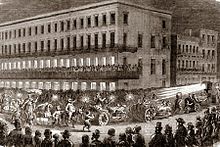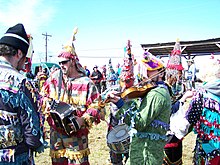Mardi Gras in the United States
The earliest Carnival celebration in North America are said to have occurred at a place on the west bank of the Mississippi River about 60 miles (97 km) downriver from where New Orleans is today.
Former French and Spanish colonies such as Pensacola, Biloxi, and settlements along the Gulf Coast all followed suit in incorporating Carnival into their annual celebrations, which today have developed either separate traditions or variations of them from one another.
The party proceeded upstream to a place on the west bank about 60 miles (97 km) downriver from where New Orleans is today, where a small tributary emptied into the great river, and made camp in what is now Plaquemines Parish, Louisiana.
[3] In more recent times, several U.S. cities without a French Catholic heritage have instituted the celebration of Mardi Gras, which sometimes emerged as grassroots movements to help accompany single people to celebrate something in late winter which is often dominated by the commercialized and couple-centric Valentine's Day, and as a result it has been co-opted as the single people's late winter holiday.
The mystic societies are organizations, similar to krewes in New Orleans, that present parades, masked balls, and activities for the enjoyment of its members, guests, and the public.
The formal dress code usually involves full-length evening gowns for women and white tie with tails for male invited guests, and masked costumes for society members.
[12][15] The Cowbellions got their start when Michael Krafft, a cotton factor from Pennsylvania, began a parade with participants' carrying rakes, hoes, and cowbells.
[14] In 1856 six businessmen, formerly of Mobile, gathered at a club room in New Orlean's French Quarter to organize a secret society to observe Mardi Gras with a formal parade.
The first organized secular celebration of Carnival in Pensacola was in 1874, when a group of men including B. F. Yniestra, D. G. and F. C. Brent, D. K. Huckley and Dr. J. C. Whiting established the Knights of Priscus Association.
"[28]The event became unorganized, having "fallen entirely into the hands of individual merry-makers and frolickers who disported themselves as their own wild merriment dictated,"[28] but was reorganized by the Clerks Union in 1900.
The public celebration is currently organized by Pensacola Mardi Gras, Inc.,with krewes parading and/or holding balls during the weekends prior to Fat Tuesday.
New Orleans Mardi Gras celebrations draw hundreds of thousands of tourists to the city to mingle with the locals at the famed parties and parades.
The group's leader, Pierre Baptiste Le Moyne, Sieur d'Iberville dubbed the spot La Pointe du Mardi Gras.
In 1833, Bernard de Marigny, a wealthy French Creole plantation owner, raised the money to fund an official Mardi Gras celebration, a parade followed by tableau and ball.
[38] The ordinance required these and other private social groups to abandon their traditional code of secrecy and identify their members for the city's Human Relations Commission.
Most of the locals who worked on the floats and rode on them were significantly impacted by the storm, and many had lost most or all of their possessions, but their enthusiasm for Carnival was even more intense than usual and celebrated as an affirmation of life.
In 1926, Ferde Grofe wrote an orchestral cycle called the Mississippi Suite, the last movement featuring a musical depiction of Mardi Gras in the French Quarter.
Since then the influence of Fat Tuesday on American culture has only increased, as evidenced by the wealth of songs, films, and television shows about the notorious festival.
Alexandria, which is located in the heart of Central Louisiana (CenLa), enjoys a blend of Mardi Gras traditions in keeping with the area's reputation as the "cultural crossroads" of the state.
Lafayette is home to the state's second largest Mardi Gras celebration,[40][41][42][43] which includes eight parades of floats and bands during the Carnival season.
[56] Other Louisiana cities holding Mardi Gras parades include Bogalusa, Bush, Chalmette, Columbia, Covington, Gretna, Kaplan, La Place, Madisonville, Mandeville, Maringouin, Metairie, Minden, Monroe, Natchitoches, Pearl River, Slidell, Springhill, and Thibodaux.
Because of violent activities of the American terrorist group, the Ku Klux Klan, Louisiana has a state law prohibiting the wearing of hoods and masks in public.
The band consists of Philadelphia's top musicians who come together once a year for this colorful celebration of music, beads, dancing, drinking, and general merriment.
The current Mardi Gras was revived in 1985 by George P. Mitchell; unlike its New Orleans counterparts, there are no celebrations held on the Monday prior to Fat Tuesday.
Around 2007, the Park Board slashed $800,000 in their budget due to deficits, and decided to drop the admission fee for the 2008 season and forgo live music performances.
[72] The admission fee has returned – which now includes both weekends prior to Fat Tuesday despite the hiring of 30 security officers to augment local law enforcement.
Vendors and Downtown Galveston businesses have reported a drop in their sales despite the promoter bringing more live music, parades, and added security which includes metal detectors and bag checks.
[83][84] As of January 2013, the $17 admission fee is still imposed by Yaga's Entertainment – one Strand business, Crow's Southwest Cantina, has circulated a petition since Dean is allegedly profiteering but has stated that a free Mardi Gras is unsustainable.
Galveston Convention Center and Visitor Bureau chair Leah Cast stated on FOX 26 Houston that charging the admission fees brings in a quality event inclusive of Grammy-nominated musicians and balcony parties.
Angry revelers threw beer bottles, trash cans, and barricade fencing at the police where video footage were posted on YouTube.

















